By Eric Vandenbroeck
30 June 2021
Interest in the idea
that alien beings might be visiting Earth from off-planet has skyrocketed in recent
years, particularly after the Pentagon verified that several videos showing
what look to be objects moving at incredible speeds and with remarkable agility
had indeed come from official U.S. Navy sources.
Kenneth Arnold (as
detailed below) was the first person who came to 'fame' by claiming to have
seen a number of UFOs seemed to understand this better than most that if
anything he not seen a real craft. Instead, he suggested that “flying
saucers are living things that dwell in the earth’s atmosphere, ‘becoming
visible at certain stages in their life cycle.’ - “It’s the way they move,” he
insisted. “It’s more like something alive than a mechanical craft.” He
believed these living bodies could blink into apparent nothingness depending on
various biological and environmental factors. “We know that water can disappear
into the air in the form of water vapor and then reappear,” he told The
Oregonian. “Some creatures in the sea can make themselves visible or invisible
at will. Why
not creatures in the air?”
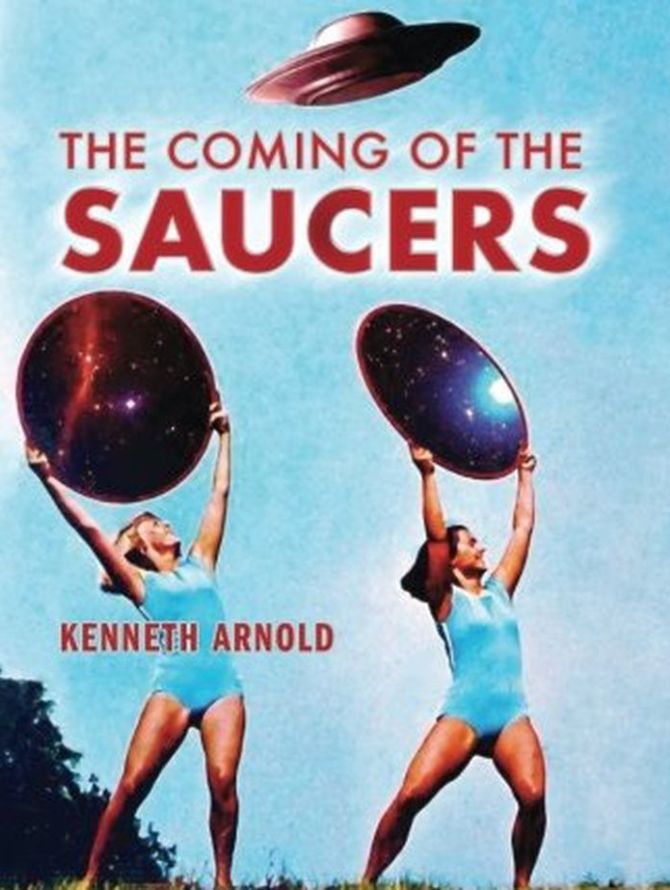
Americans, including
various people in other countries, are ready to believe. A 2019 Gallup
Poll found that a
third of U.S. adults agreed with the idea that "some UFOs have been alien
spacecraft visiting Earth from other planets or galaxies."
Thus much has been
made about the de-classified government report on UFOs issued on Friday
whereby even Politico published an article that spins a conspiracy theory.
Since the UFO report doesn't include everything the writer wants, he asserts
(w/o proof) that there is "undoubtedly"
hidden "information" withheld from the UFO task force and asks for
Congress to seek answers.
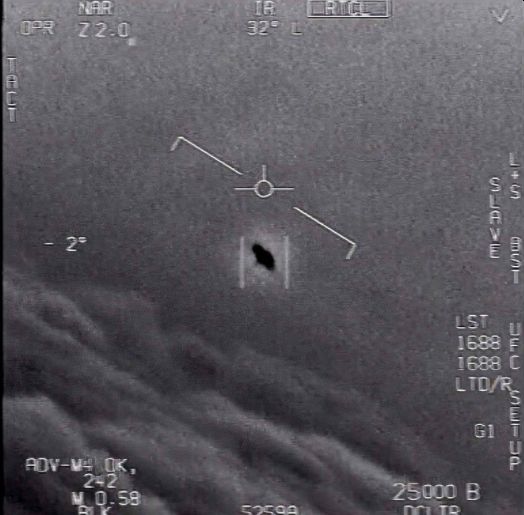
A lot has been
made of an unusual provision in a pandemic relief bill passed last year
that required
government agencies to
provide an analysis of “unidentified
aerial phenomena,”
or, in layman’s
terms, UFOs.
The ensuing report
out Friday,
however, rains on the parade of those who hoped the
military would determine there
was alien activity on Earth: It found no
evidence that UFOs are
alien in origin.
Except on Fox
news last night:
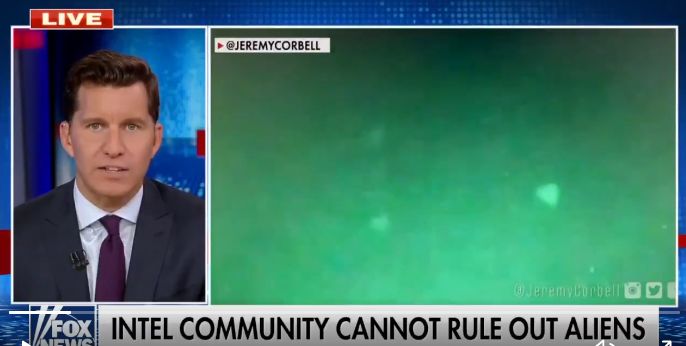
While the above
mentioned report is the result of lobbying from UFO
advocates, the actual report was written by a small number of career
staffers with no known connection to UFO advocacy. While there were a few
takeaways that believers see as sensational, the overall tone is one of concern
that the lack of evidence leads to potentially faulty conclusions. The task
force seems to have conducted only secondary research, reviewing testimony and
sensor reports, but conducting no original research. There is also no mention
of consulting relevant outside experts, or even of studying the sensors
detecting the vast majority of so-called encounters. Overall, the report is
highly provisional and better serves as a call for a new UFO program, something
the Pentagon quickly implemented, and a brief for more funding, more defense
contracts, and more consultants.
As already reported
as far back as 2019 by the Washington insider publication The Hill the areas of
research that were being funded by the program seemed to be things out of “Star
Trek.” One grant was for the study of “Traversable Wormholes, Stargates,
and Negative Energy” conducted by Eric W. Davis of EarthTech
International Inc. Another grant was for the study of “Invisibility Cloaking”
by German scientist Ulf Leonhardt, at the Weizmann Institute of Science in
Israel. Yet another area of study was “Warp Drive, Dark Energy, and the
Manipulation of Extra Dimensions” conducted by Richard Obousy,
a theoretical physicist and director of the nonprofit Icarus Interstellar.
In an article posted
on 22 May 2021, about Senator Harry
Reid and Robert Bigelow we described how the money for the
government report on UFOs delivered to
Congress on Friday as
a landmark sign that this previously fringe topic has gained mainstream
acceptance and thoroughly debunked the most crucial
item in the report (the same item that is now also mentioned in
Politico 6/25/2021 article as pictured above).
In 1995, Bigelow
founded the National Institute for Discovery Science to research and advance
study of various fringe sciences and paranormal topics, most notably ufology.
The organization researched cattle mutilation and black triangle reports,
ultimately attributing
the latter to the military. The top man at NIDS is a familiar name to
anyone who ever waded into these esoteric topics: Retired U.S. Army Col. John B. Alexander, the real-life psychic Jedi warrior in Jon Ronson’s book The Men Who Stare At Goats. Alexander is
called “Col. Harold E. Phillips” in longtime Vanity Fair reporter Howard Blum’s book about Reagan-era UFO hunting
by the Pentagon, Out
There The Government’s Secret Quest for Extraterrestrials. The rest of the NIDS crew had similarly spooky backgrounds.
In December 2017,
Bigelow was reported by the New York Times to have urged Senator Harry Reid to
initiate what became the Advanced Aerospace Threat Identification Program, a
government study tasked with the study of UFOs. According to the New York
Times, Bigelow said he was “absolutely convinced” that
aliens exist and have visited Earth. In June 2020, Bigelow founded the
Bigelow Institute for Consciousness Studies to support investigations into life
after death. In January 2021, he put up an award of $1 million for anyone who
could demonstrate the
existence of life after death.
From esotericism to alleged Science
In fact, the same
people that are currently into UFOs are the same kind of people that were
driving this movement in the late 1940s (where also there already the Pentagon
started its Project Sign, out of concern that such sightings could be
advanced Soviet weapons) to 60' and '70s. So in this article, we will point
out some of the sources that might have led people like Robert Bigelow and
others to 'believe'.
During this era, the
explosion of UFO stories sprung from fears about the Cold War and, specifically
in terms of flying saucers, arises two years after the explosion of the atomic
bomb in World War II. And it was also then already that such people like
psychiatrist Carl Jung theorized this positive spin on UFOs had to do with
religion's inability to ease people's fears about nuclear war.
What started it all
was that in 1947 Kenneth Arnold reported seeing nine objects near Mount
Rainier, which he shows on hand form a reconstruction here:
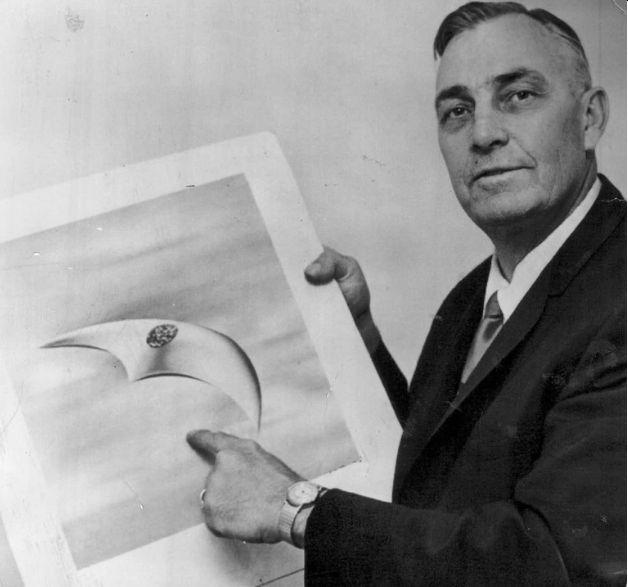
Lesser known is that
it for the first time was mentioned by 'Fate' Magazine, which covered
divination methods, Fortean events, belief in the survival of personality after
death, predictive dreams, accounts of ghosts, telepathy, archaeology, flying
saucer sightings, cryptozoology, alternative medicine, warnings of death, and
other paranormal topics, many contributed by readers. Ray Palmer, the publisher
of Fate, was the first to report Kenneth Arnold's report as flying discs.
Whereby the
early June 24, 1947 sighting of Arnold news stories didn't mention
"flying saucers" or "flying discs."
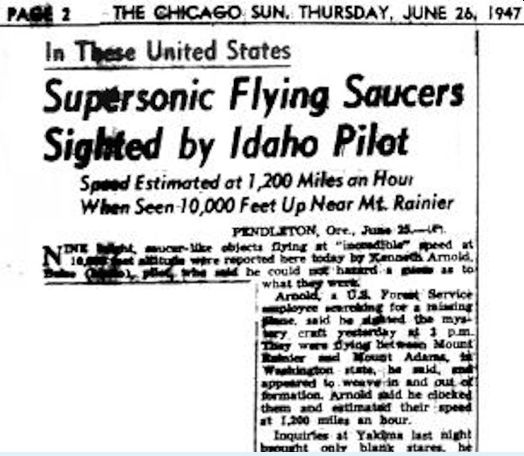
This changed with Ray Palmer who was the first to dedicate a full article
alleged Arnold citing in his very first issue of Fate magazine:
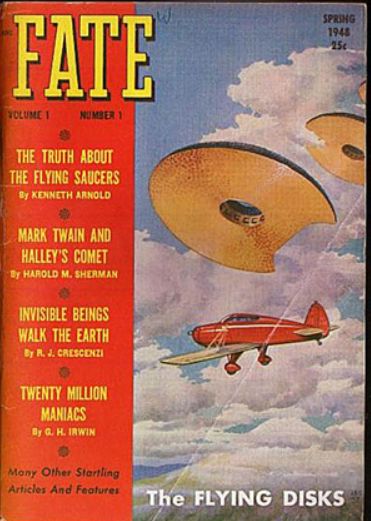
Dubbed "The Man
from Mars," Palmer's biographer Fred Nadis
recounts how from 1945 to 1947, Palmer ran a series in Amazing known as the
Shaver Mystery (or, to many, the Shaver Hoax). Author Richard Shaver wrote
about a subterranean world inhabited by “Deros.”
Traveling about in flying disks, these demonic creatures were responsible,
employing secret rays for most of the ills of Mankind. Shaver claimed to have
actually visited “the caves” and insisted his stories were factual. And in
Fate, Palmer then promoted a new theory: that flying saucers came from Outer
Space.
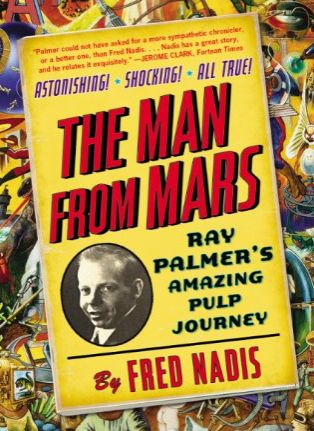
When Palmer also
co-authored a book with Arnold, founded a press specializing in UFO
publications, and (in the opinion of some) mischievously transformed the alien
spaceships of science fiction into the flying saucer phenomenon.
As the space age
dawned, in publications such as Fate, Mystic, Search, Hidden World, Flying
Saucers from Other Worlds, and Space World, Palmer thus made
himself an impresario of the paranormal and shaped the sensibility of an
underground community. His loyal readers embarked on an endless mystery tour
careening between the real world and the pulp wilds. He offered unorthodox
ideas to shake things up, overturn preconceptions, and create mystique. Year
after year, to all comers, Palmer generously offered his prime commodity: tales
wrapped within tales, conspiracies within conspiracies, and worlds within
worlds; to use sixties’ jargon, his humble goal was to “blow your mind.”
Maybe tellingly, when
in the 1960s, famous UFOlogist Jim Moseley
made a pilgrimage to the Wisconsin farm where Ray Palmer ("the
man who invented flying saucers") spent most of his later years.
Palmer asked Moseley rhetorically, “What if I told you it was all a joke?”
Palmer's cryptic
remark, “What if I told you it was all a joke?” might be understood when we
realize that Kenneth Arnold claims we can safely
say was influenced by the Maury Island UFO Hoax, which Ray Palmer had sent Kenneth Arnold out to
investigate. It was this made-up UFO sighting promoted by Ray Palmer that
inspired the term “flying saucer.” Not surprisingly, Palmer also went on
to co-author a book with Arnold, founded a press that specialized in UFO
publications, and (in the opinion of some) mischievously transformed the alien
spaceships of science fiction into the flying saucer phenomenon.
Kenneth
Arnold suggested that “It’s the way they move,” he insisted. “It’s
more like something alive than a mechanical craft.” He believed these
living bodies could blink into apparent nothingness depending on various
biological and environmental factors. “We know that water can disappear into
the air in the form of water vapor and then reappear,” he told The Oregonian.
“Some creatures in the sea can make themselves visible or invisible at will. Why
not creatures in the air?”
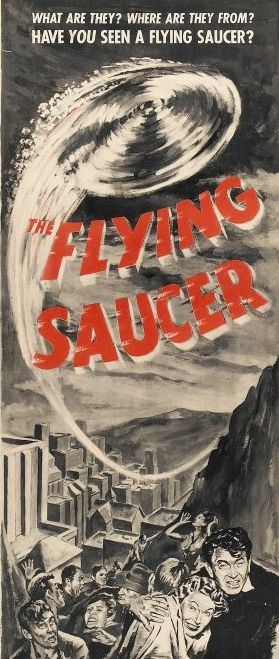
Shortly thereafter,
on July 8, 1947, Roswell Army Air Field issued a press release stating that
they had recovered a "flying disc" from a ranch near Roswell. The
Army quickly retracted the statement and said instead that the crashed object
was a conventional weather balloon. Thus when In 1947, a high-altitude
balloon crash-landed in Roswell, the aliens never left.
In fact, it would
remain vital in the years to come. Over the next decade, flying saucers would
become a ubiquitous feature of popular culture, starring, with tones of both
wonder and fear, in comic books and TV shows and movies. There was 1950’s The Flying Saucer. And Flying Disc Man from Mars. 1956 brought Earth vs. the
Flying Saucers. And
1957 brought Invasion of
the Saucer-Men.
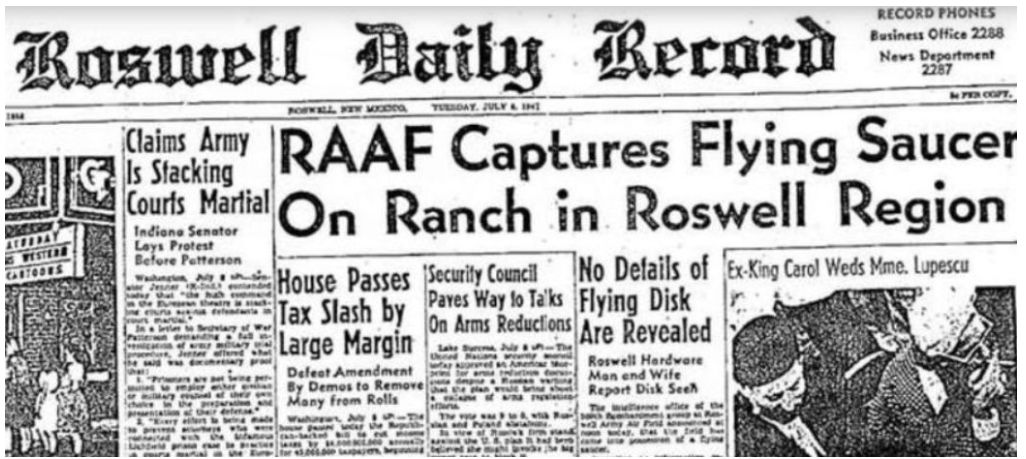
Showing pentagon
interest didn't start with the current declassified government report on
UFOs already in 1948 a project was established by Air Force General
Nathan Farragut Twining, head of the Air Technical Service Command, named
Project SAUCER and later that year renamed Project Sign. The goal of
the project was to collect, evaluate, and distribute within the government all
information relating to UFO sightings, on the premise that they might represent
a national security concern.
At first, the project
hypothesized the sightings might be Soviet secret weapons. However, Project
Sign's final report, published in early 1949, stated that while some UFOs
appeared to represent actual aircraft, there was not enough data to determine
their origin. Almost all cases were explained by ordinary causes, but the
report recommended a continuation of the investigation of all sightings.1
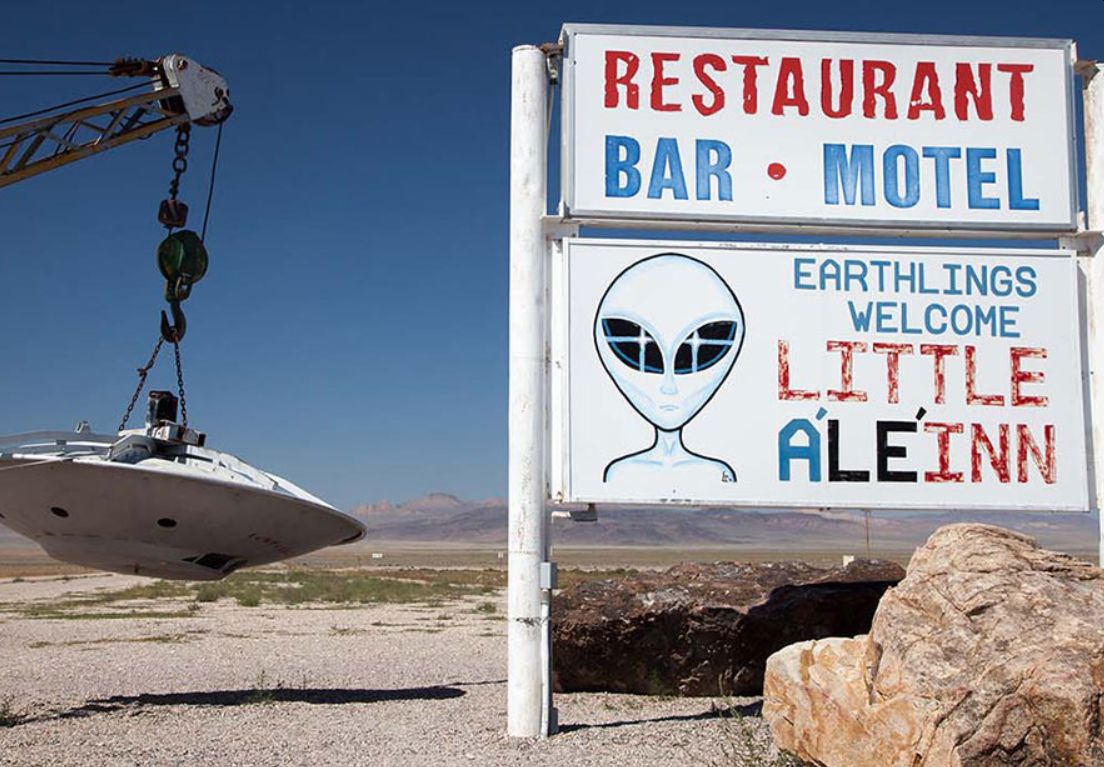
The Esoteric precursor and the first report of an
alien abduction
Apart from pulp
fiction which, as we described, also led to
Scientology, there is an earlier precursor that also might have
inspired the ancient astronaut theory
first popularized by the "Occult Science" of H.P. Blavatsky, who
wrote in her widely sold book "The Secret Doctrine" (which claimed to
reveal "the origin and evolution of the universe and humanity
itself") that already during the time of "Atlantis" there were
flying machines and that knowledge of such machines "was passed on"
to later generations in India. Similarly, the founder of today's top-rated
Waldorf schools Rudolf Steiner, also claimed that the Atlanteans had aircraft
that had steering mechanisms by which they could rise above mountain ranges.
According
to Mikael Rothstein Several “UFO religions” are expressions of
Theosophical imagination and social entrepreneurship. Rothstein writes
that during the 1950s, Theosophically-inclined flying saucer enthusiasts
revivified the Mahatmas of classical Theosophy by reinventing them as
benevolent “Space Brothers” arriving on Earth in physical vehicles to
teach and protect the self-destructive children of the planet. The notion
that the Mahatmas originated from somewhere special, or belonged to a place out
of reach, was by classical Theosophical ideas, but distant planets provided a
new and fresh realm for Theosophical imaginations.2
The person is known
to be the first to have ever reported an alien abduction, William Dudley
Pelley, as we reported clearly was influenced by such
beliefs. And similarly can be said about among
others George Adamski.
The man who told the world UFO's had landed
To some, he was a prophet.
To others, a laughing stock. Even today, more than half a century after his
death, George Adamski remains one of the most curious and controversial
characters in UFO history.
George Adamski,
who initially was employed as a maintenance worker in Yellowstone National
Park influence by Theosophy later in 1932, wrote a short story revolving around
spiritual contacts with mysterious, highly evolved beings which included
the mention of an alleged Royal Order of Tibet on p.23. But Adamski's career as
a visionary mystic really started when, after having read his story Lalita
(Maud) Johnson invited Adamski to teach at the Little White Church for the
Order of Loving Service, which she established earlier that year in Laguna
Beach, an artists colony on the California coast.
Whereby less than two years after that, still heavily influenced by
Theosophy, The Royal Order of Tibet opens its ‘monastery’ the Temple
of Scientific Philosophy in Laguna Beach:
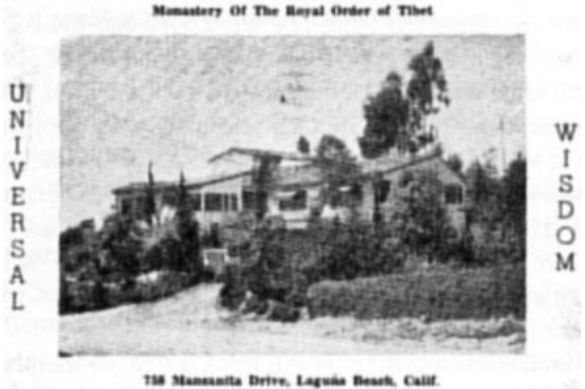
A decade
after he wrote his 1932 story, the same claims would again be presented,
but this time as biographical facts of Adamski’s own life. Other texts from
this involvement with the Royal Order of Tibet were reworked, and
(initially an idea that sprang from Spiritualism where it was
called 'spirit guides' the Theosophical
Mahatmas were replaced
with aliens.
In fact, Adamski
ended up with multiple claims to UFO fame. Starting in the late 1940s, he took
countless photos of what he insisted were flying saucers. But experts,
including J. Allen Hynek, scientific consultant to the Air Force’s Cold
War-era UFO investigation team Project Blue
Book, dismissed them as
crude fakes.
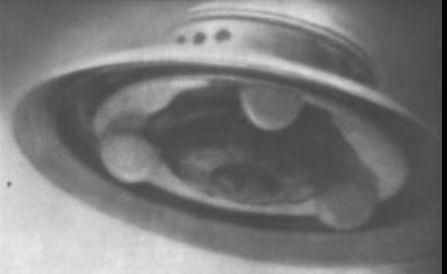
This included
Adamski's infamous "chicken brooder" photograph, which he claimed to
be of a UFO, taken on 13 December 1952. Soon thereafter, German scientist
Walther Johannes Riedel said this photo was faked using a surgical lamp and
that the landing struts were General Electric light bulbs.
Adamski chronicled
his alleged adventures in several books. The first, Flying Saucers Have
Landed (1953), co-authored with Desmond Leslie, recounted his chat with
the Venusian. Widely read at the time, it later gained a new generation of fans
in the trippy 1960s.
Adamski immediately
became a major flying saucer celebrity after the release of his 1953 book,
where he told the story of encountering and communicating with Orthon, the pilot of a landed extraterrestrial spaceship.
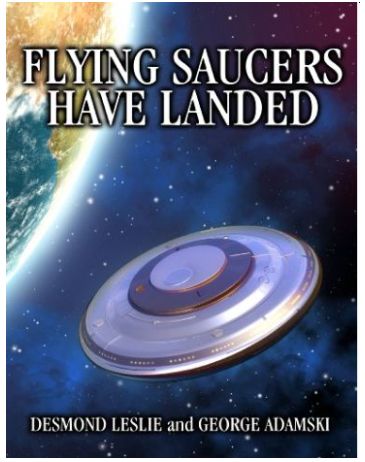
Adamski’s 1955
sequel, Inside the Space Ships, described further meetings, not only with
the Venusian but also with emissaries from Mars and Saturn. In Adamski’s
telling, every planet in our solar system was populated with human-like
inhabitants, as was the dark side of the earth’s moon.
In the 1955 book,
Adamski claimed that his new friends took him aboard one of their scout ships,
flew him to an immense mother ship hovering over the earth, gave him a ride
around the moon, and treated him to a colorful travelogue about life on Venus.
Along the way, he was
also tutored by a spaceman he called “the master.” The master, who was said to
be nearly 1,000 years old, shared the secrets of the universe with Adamski,
only some of which he was allowed to divulge back on earth.
Adamski's following
vision of a friendly, laid-back alien race is strikingly different from the
descriptions of the bulbous, bug-eyed alien "greys" that UFO
abductees speak of today. Adamski described Space Brother Orthon as tall, blond, humanoid with tan skin and
brown shoes. Additionally, Adamski said that Orthon left
mysterious symbolic imprints in the ground where he walked.
Preposterous as his
stories seemed, Adamski became an international celebrity and lectured widely.
Queen Juliana of the Netherlands raised a public stir after inviting him to her
palace in 1959 to discuss extraterrestrial doings. Adamski supposedly claimed a
secret 1963 meeting with the pope, as well.
Adamski soon had
followers all over the planet. But not everybody was on board. Arthur C. Clarke, the author of 2001: A Space Odyssey, not only denounced Adamski’s work but characterized
his believers as “nitwits.”
The "Aryan"
appearance of spacemen spotted by Adamski and others might also have helped
give rise to a theory that UfOs represented a secret
weapon of remnants of the Third Reich. A topic taken up by both former SS Wilhelm Landig and Rudolf J. Mund (who
in 1979 became prior of the Ordo Novi Templi and
claimed to have been the inspiration for Landig's "Götzen gegen Thule. Ein Roman voller Wirklichkeit. 1971 the
book which started the Nazi-UFO craze).
The time when UFO research became respectable
In 1966 J. Allen
Hynek, the astronomer who pioneered the scientific study of UFOs for the Air
Force’s Project Blue Book, told his friend, French UFO researcher Jacques Vallée, his deep dark secret: In terms of his scientific
outlook, he wasn’t a strict materialist; instead, he was guided by his
fascination with mysticism and the occult. Over the next decade, the two men
toyed with the notion that UFOs weren’t alien spaceships at all but, rather,
space poltergeists from another dimension. The two men’s discussions profoundly
impacted a friend with an office near Vallée’s in the
1970s, an ex-Scientologist and physicist named Harold E. “Hal” Puthoff. Puthoff, who studied
psychic phenomena at the Stanford Research Institute, championed debunked
spoon-bender Uri Geller, was also a defense contractor. The intelligence
community recruited him for a bonkers effort to use psychics. To spy
telepathically on the Soviets, later known as “Project
Stargate.” In 1984, one
Stargate “psychic” claimed to travel back in time one million years to commune
with Martians.
By 1949, the
Pentagon officially dismissed UFOs as a product of hoaxes,
misidentification, hallucinations, and mass hysteria. To convey this to the
public, military officials worked closely with the Saturday Evening Post on a two-part article that
derided the idea of intergalactic ships whirring through the skies. “It is a
jittery age we live in,” the magazine concluded, “particularly since our
scientists and military spokesmen have started talking about sending rockets to
the moon… it is a small wonder that harassed humans, already suffering from
atomic psychosis, have started seeing saucers and Martians.”
Instead of putting
the matter to rest, as the Pentagon hoped, the article aroused ire and
disquiet. Concerned that its public engagement was feeding into the country’s
“war nerves,” the Pentagon resolved to go silent on UFO commentary.
Into this vacuum
stepped a group of citizen crusaders, rank opportunists, and con artists. One
leading voice was retired Marine Corps Major Donald Keyhoe,
who in January of 1950 published a widely circulated article in True Magazine titled, “Flying Saucers are
Real.” UFO sightings were soon taken up by mainstream media’s most iconic and
influential publications. In 1952, Life Magazine published a lengthy article titled, “Have we, visitors, from outer
space?” This was a watershed moment, writes Mark O’Connell in his recent book,
The Close Encounters Man. “When Life spoke, the whole country listened,” he
writes.
Book titles convey
some of the period's mood: Flying Saucers: The Startling Evidence of the
Invasion from Outer Space; Flying Saucers are Hostile; Flying Saucer Invasion;
Target Earth; Flying Saucers, Serious Business; The Real UFO invasion; The
Terror Above Us. The teaser on The Official Guide to UFOs promised, “Exclusive!
First News of America’s Most Terrifying UFO Invasion!” Wilkins’s books return
with arch blurbs asking, “Are they Friendly Visitors from Outer Space or
Invaders Planning Conquest?” and “Is there a cosmic battle plan aimed at
Earth?” The actual content was less dramatic than advertised, but that hardly
mattered. The conviction of urgency transcended the material gathered for
proof.
Throughout the first
half of the decade, Donald Edward Keyhoe, who
in 1956 founded the National Investigations Committee on Aerial Phenomena
(NICAP) that next pressed for Congressional hearings on the UFO problem by such
tactics as letter-writing campaigns. The Air Force warned members of Congress
such hearings would only dignify the problem and cause more publicity, thus
adding to the problem. NICAP also published a book called The UFO Evidence
(edited by Richard Hall) and sent copies to members of Congress to put forward
their case that UFOs were, in fact, real and posed a danger to the fabric of
society. The danger included an unprepared public being caught up in widespread
panic if an external danger was suddenly imposed. A sudden confrontation with
extraterrestrials could have disastrous results, they warned. Among them,
“catastrophic results to morale.”
Then there the
writings of Carol E. Lorenzen that were required reading for American UFO buffs
in the sixties. Flying Saucers: The Startling Evidence of the Invasion from
Outer Space (1966) builds on Donald Keyhoe's thesis
that UFOs are engaged in reconnaissance. They are painstakingly mapping the
geographical features of our country and testing our defense capabilities. The
1952 Washington D.C. incidents are regarded as accidental incursions by aliens
mistaking the capitol and White House for military installations.
The Lorenzen's expect they will be setting up bases since the taking
of plants, boulders, and soil samples probably mean they are testing what sort
of agriculture they should establish. The Ubatuba explosion
is regarded as selfdestruction to prevent
superior technology from getting into our hands and revealing its secrets.
There is a bare possibility it was an atomic explosion. “UFOs are powerful
radioactive sources.” The dangers they pose extend to the possibility that our
next war could involve “all nations fighting as brothers against a common foe
from outer space.”3
They showcase the ideas
of Dr. Olavo Fontes that UFOs possessed
weapons like heat rays and a device that inhibited the function of petrol
engines. However, they claim priority that the observations UFOs made of cars
and planes in the early years were done to devise these antimachine machines to
disable propulsion systems.
A pattern of
reconnaissance is seen, which suggests to them that aliens plan to release
sleeping drugs into strategic reservoirs and water tanks as a means of bringing
the world to its knees in a matter of hours. They are concerned there are too
many blackouts on our power grids. There are also people disappearing. Is this
the procuring of specimens? Add to this the case of a woman with medical
problems they interpret as radiation effects. No person of conscience can
ignore the UFO problem in the light of all this. The UFO problem has to be
taken out of the hands of the military, who are lulling us into a false sense
of security, and given to an international commission who will handle this
red-hot political problem.
“We are in urgent
need of the acquisition and objective analysis of basic data.” We are facing
potential danger. Maybe they aren’t hostile, but “there is no indication of
friendliness either... The existence of a species of superior beings in the universe
could cause the civilization of Earth to topple.” This urgency “defies
expression.” We must be anxious to relearn the lessons of history; Billy
Mitchell, Maginot, Pearl Harbor, and so on.
Credit must be given
where it is due. The Air Force got it right and told it straight. No material
threat to national security existed. The invasion never took place. Mirarchi’s Pearl Harbor, Riordan’s knockout
attack, Kevhoe’s final operation, Wilkins’
death ceiling blockade, Michel’s Sword of Damocles, NICAP’s danger to the
fabric of society, the Lorenzens’ mass drugging
and the toppling of civilization, Edwards’ imminent Overt Contact, Fawcett’s
disaster beyond imagination, Steiger’s full-scale
annihilation, Hvnek’s Russian Breakthrough, Clark’s
swamp-lurking village-slayers, Palmer’s ongoing titanic war, Fowler’s cultural
disintegration: all were concerns with more basis in fantasy than reality.
The sense of urgency,
the sense that it may be too late, the sense that our existence depended on a
properly conducted investigation was an irrational fear. The Air Force
repeatedly tried to get across the message that UFOlogists were
wrong, but they were in no mood to listen. It is dogma among UFOlogists that the Air Force was incompetent or worse, yet
if that is accepted as a proper, measured evaluation, what word is proper to
describe the body of thought presented by these UFOlogists?
The Air Force did not perform flawlessly in the details, but they had the big
picture in more than sufficient focus to understand it was a nuisance problem
and not one of life and death significance.
The same cannot be
said of UFOlogists. For them, the big picture
keeps changing. In the fifties, they were considerate and peace-loving. In the
sixties, they were a source of danger and death. The seventies were perversely
irrational and a source of hope. In the eighties, they were traumatizing though
they didn’t realize it.
The 1960s also saw
many other flying saucer groups like The Adamski Foundation, Mark-Age. Universaucerian Foundation, Aetherius Society,
World Understanding, Association of Sananda and Sanat Kumara, The Unarius Academy, and Rael are
usually called UFO religions.
Hence the sightings
of 1947 of which Ray Palmer said, “What if I told you it was all a joke?”
quickly spawned major actors, organizations, and schisms that would
dominate the UFO movement for decades.
Project Blue Book and the plethora of UFO news
Deep public concern
about UFO sightings in 1966 pressed the Air Force into funding an external
evaluation of Project Blue Book. This work, directed by Edward Condon, an
eminent physicist at the University of Colorado, was completed in 1968 and
concluded that there was no evidence supporting a belief in alien visitation
and that UFO phenomena do not offer a fruitful field for scientific
discoveries. The National Academy of Sciences reviewed Condon's report and
concurred with his conclusions. Project Blue Book was terminated in 1969.
Of more than 12,000
sightings eventually registered by Blue Book, over 90 percent were plausibly
attributed to misidentifications of celestial objects such as Venus, of
human-made objects like weather balloons or artificial satellites, or hoaxes
(Condon 1968: 11). Surely there are errors in attribution, but activists and
skeptics agree that the vast majority of UFO reports indicate nothing
extraordinary.
While valueless for
physical scientists or engineers, these sightings are useful for sociologists,
showing the context in which ET claims occur. For example, UFOs are usually
seen after dark but before midnight, and more often in warm months than winter.
This reflects the times when people are outside looking at the night sky. Many
nations report UFOs, but the United States is the center of activity. Within
the U.S., the geographical distribution of sightings correlates roughly with a
density of non-urban population. Few reports come from urban areas, probably
because city lights obscure the night sky.
The Air Force count
of UFO sightings ceased with Blue Book's demise. Ufologists remedied that loss,
one of whom, Larry Hatch, has for twenty years tabulated sightings worldwide
and posted them in graphical format on the internet. Like Blue Book, Hatch's
unit of analysis is the UFO event, that is, the sighting of one or more
extraordinary objects in the sky, or if on the ground thought capable of
flight, at a particular time and place by one or more observers. His
compilation includes Blue Book; journals, newsletters, and encyclopedias from
UFO organizations; news media; and private catalogs.
By Hatch's count, the
greatest number of sightings for one year occurred in 1952. In March 1952, the
Air Force consolidated its previous UFO inquiries into Project Blue Book,
enlisting intelligence officers at all Air Force facilities to assess and
report saucer sightings. This improvement in data collection may account for
increased sightings in April and May but seems insufficient to explain the
dramatic upturn during the summer.
The news media are
another candidate. The Air Force's invigorated UFO inquiry was the lead-in for
a highly influential story in Life magazine of April 7.9 Titled "Have We
Visitors from Space?" Life's answer was essential "yes." Some
350 newspapers quoted the piece within days of its release. Media attention
rose more sharply in July. The New York Times, for example, averaged only three
UFO articles per month during the spring of 1952 but ran 17 articles in July,
another 37 in August, and then by September nearly dropped the story.
The last three months
of 1957 saw another flap, especially in November. Blue Book attributed many of
these sightings to misidentifications of Venus. No increase in UFO news
articles accompanied this peak, perhaps because journalists were focused on
Sputnik 1, launched by the Soviet Union on October 4, and Sputnik 2 with the
dog Laika on November 3. Headlines were plentiful, inducing people to watch the
skies.
A plethora of UFO
news began in March 1966 with repeated reports by many witnesses of glowing
colored lights in two swampy areas near Ann Arbor, Michigan. Dr. Hynek, the Air
Force consultant, thought these were visual effects of swamp gas or foxfire
from rotting vegetation, producing a phosphorescent glow. Though scientifically
reasonable, this "marsh gas" explanation was derided as a cover-up.
Michigan congressman (later president) Gerald Ford called for a congressional
investigation. House hearings in early April produced more news coverage. The
publicity was a boon to the authors of some twenty-five books on UFOs published
between 1965 and 1968. John Fuller, a columnist with Saturday Review magazine
and a UFO believer, was the major beneficiary, fortuitously publishing two
saucer books in 1966. Sightings rose apace with the publicity, peaking in 1967.
Sightings peaked again
in fall 1973. This flap started in the southern states and might have gone
unmentioned in The New York Times if Georgia Governor Jimmy Carter had not
commented that he once saw a UFO (September 14). In mid-October, the Times
reported that a UFO seen by thousands of South Carolinians turned out to be the
work of an artist who launched the object as an experimental sculpture. About
the same time, two shipyard workers from Mississippi, while fishing on the
Pascagoula River, were nabbed by hideous-looking aliens, taken aboard the
spacecraft for examination, and then released. A local lawyer, acting as the
abductees' agent, sought payment for the Pascagoula story. The men repeatedly
appeared on network television despite the transparency of their hoax. By this
time, there were sightings around the nation.
But in the end, the
project concluded: "No UFO reported, investigated, and evaluated by the
Air Force has ever given any indication of threat to our national
security." According to the National Archives fact sheet, the program also
concluded that the "unidentified" sightings were not advanced
technology or extraterrestrial vehicles.
The project was
closed down in 1969 because of its cost, the National Archives said.
The Heaven’s Gate suicides
After 1973 news
reporters ignored UFOs except for a brief but intense return in 1997. There
were two big saucer stories that year. In March, the bodies of 39 members of a
millennial sect called Heaven’s Gate were found at a wealthy estate in
California, victims of a mass suicide intended to remove them from their
earthly bodies so they could join a spaceship lurking behind the Hale-Bopp
comet, then passing near earth. In a lighter vein, many thousands of partiers
gathered at Roswell, New Mexico, on the Fourth of July for the fiftieth
anniversary of the crash of a flying saucer containing alien bodies, not all
dead, that are still held in secret storage by the Air Force.
As we have seen
above, as it relates to Area 51, the seed for the Roswell story was the crash
of a government balloon on a nearby ranch in early July 1947. This was barely a
week into the media frenzy set off by Kenneth Arnold’s “saucer” sighting near
Mount Rainier. The rancher who found the wreckage notified the sheriff, who
contacted Roswell Army Air Field, which picked up the debris. The base’s
zealous public information officer, Lieutenant Walter Haut, wrote a press
release saying that the Army had retrieved the wreckage of one of the rumored
flying discs. The Roswell Daily Record ran the story under the headline, “RAAF
Captures Flying Saucer on Ranch in Roswell Region.” By the following day,
higher-ups in the Army identified the wreckage as a weather balloon, but that
was not completely true. In 1994 the Air Force revealed that what crashed at
Roswell was a 600-foot long train of weather balloons and radar targets then
tested for Project Mogul, a top-secret attempt to detect sound generated by
Soviet nuclear-bomb tests.
What is most
remarkable about the Roswell crash is that it was virtually a non-event for
four decades. I found a mention of Roswell in my perusal of UFO literature
barely before 1990. The exception was a book called The Roswell Incident, but
its absurdities (e.g., President Eisenhower lacked sufficient security
clearance to be told about the downed saucer) gave it little credibility even
among UFO believers. Roswell was reinvigorated in the early 1990s as new books
promoted theories about one or more crashed saucers, recovered bodies, perhaps
a survivor, and of course, a cover-up.
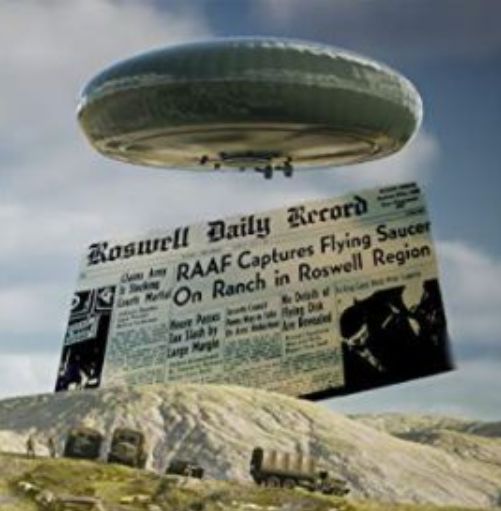
Alleged Alien Abductions
During the mid-1980s,
several sensational books, presented as nonfiction, explicated the phenomenon
of alien abduction, including intrusive medical examinations and the extraction
from unwilling donors of sperm and ova, to be used in fertility experiments.
There were accounts of hybrid fetuses taken from pregnant women and hybrid
children shown briefly to their human mothers but kept by the aliens (Strieber
1987; Hopkins 1981, 1987; Jacobs 1992; Mack 1994). According to this
literature, abduction and hybridization are commonplace, but since the aliens
induce amnesia, contactees are barely aware
of their encounters until memories are restored under hypnosis. The most
commercially successful of these books, leading the New York Times bestseller
list by May 1987, was Communion by Whitney Strieber, a well-known author of
horror fiction, who wrote of his own abduction and traumatic medical
examination by aliens. A movie version of Communion, starring Christopher Walken, followed in 1989, and following that was a wave of
reported abductions.
In 1994, the
abduction phenomenon got an enormous boost from the trade publication of
Abduction: Human Encounters with Aliens by Dr. John E. Mack, a long-time
professor of psychiatry at Harvard Medical School and winner of a Pulitzer
Prize in 1977 for a biography of T. E. Lawrence. Mack had been introduced to
the abduction phenomenon in January 1990 by Budd Hopkins, an accomplished
artist and amateur hypnotist who had worked with abductees for over a decade.
In 1987 Hopkins had published Intruders, a book on the reality of alien
abduction. By 1992, after Intruders was reshaped as a fictional TV movie, the
lead character was a Mack-like psychiatrist (played by Richard Crenna) working with abductees. Both Mack and Hopkins were
consultants on the film.
Dr. Mack provided a
level of credibility that Hopkins or any other UFO believer could not approach.
He provoked a storm of controversy at Harvard, including a Medical School
investigation of his work with abductees. Still, tenure and the spirit of
academic freedom preserved him from serious censure. In the paperback edition
of his book, Mack slightly moderated the sensationalism of the original
hardback, stating that he did not presume that everything abductees told him to
be literally true. Still, he vigorously defended the credibility of abduction
experiences until he died in 2004, struck by a bus in London. It remains
puzzling why a physician of Mack's stature would espouse so implausible a
phenomenon. He did have a history of flirting with dubious practices like
Werner Erhard's EST and Stanislav Grof’s "holotropic breathwork," a technique that allegedly
accesses extraordinary states of consciousness. Whatever his motives, the
Harvard professor and the mass media carried alien abduction a long way from
the fabulous tale of Barney and Betty Hill.
There is no physical
evidence associated with alien visitation or abduction that cannot be explained
in ordinary terms. We have testimony from people like the Hills, who insist
that they personally experienced these events. Most do not suffer severe
psychopathology (Clancy 2005). In the clinical laboratory, when their supposed
abductions are brought to mind, these claimants show physiological signs of
stress consistent with a recall of trauma. Apparently, most of them truly
believe they were kidnapped and sexually molested by extraterrestrials.
The major argument
given to support the reality of alien abduction is that the stories told by
unrelated abductees have a high degree of consistency on specific details. What
are the broad commonalities? Most abduction occurs at night when the abductee
is alone, usually in bed or asleep. Abductees often feel paralyzed while they
are being taken. And abduction stories are generally accepted to be simply a
result of sleep paralysis.
Conclusion
In the end it
would be odd if the report instigated by Senator Harry
Reid and Robert Bigelow said the government could rule out an
extraterrestrial origin of UFOs while still knowing next to nothing about what
they are, just like it would be strange for a report on an unidentified serial
killer to determine that the killer is not from Tulsa, Oklahoma, even though
nothing else of their origins is known.
These sightings also
lack any good supporting evidence to suggest they are life from other planets:
UFOs were not observed entering our atmosphere from millions of miles away,
leaving our atmosphere while en route to another
planet or showing any sign of life, all things that would happen if UFOs really
were extraterrestrials visiting us from Alpha Centauri.
Of course, those who
believe “the truth is
out there” might point to the fact
that the government report exists at all. But government interest doesn’t
inherently mean something is real. When national security is on the line,
there’s little that government agencies (domestic and foreign) haven’t
investigated. We’re familiar with the crazy ideas that were successful (try
wrapping your head around how nuclear
weapons work), but
there are many other projects that proved to be boondoggles.
The Japanese Empire,
not to be outdone in the field of bizarre bombings, attached bombs
to thousands of balloons and
used easterly air streams to send them from Japan to the continental United
States (and Alaska and Mexico and Hawaii and everywhere in between). Aiming a
balloon at a target thousands of miles away works about as well as you’d
expect, though they did manage to kill six American civilians in Oregon with
one of the thousands of balloons released.
The Cold War saw
research projects grounded more in cheesy pulp novels than reality. The CIA was
so worried about the possibility that the Soviets had invented mind control
techniques that they tried to develop their own. Collaborating with scientists
from Imperial Japan and Nazi Germany, they gave unwitting
volunteers LSD (a
serious violation of research
ethics). They failed to
develop mind control, but they did introduce Ken Kesey (author of “One Flew
Over the Cuckoo’s Nest”) and many other countercultural luminaries to dropping
acid.
Later, a loosely
organized group of military researchers, worried about the possibility the
Soviets had recruited psychics (see a pattern here?), tried to
recruit psychics of
their own in an attempt to spy on enemy military bases, predict new types of
enemy weapons and kill goats just by touching them. They supposedly killed at
least one goat and definitively inspired a book with a movie adaptation that
starred George Clooney: “The Men Who
Stare at Goats.”
This isn’t to say
that we shouldn’t fund odd-sounding research (in fact, it’s vital
that we do) but
merely to say that government funding does not by itself prove an idea is
reasonable. (For a nonmilitary example, remember the bridge to nowhere?)
Ultimately, UFOs
should be investigated not because we might need to call in Will Smith to
fight aliens but
because other, more plausible, explanations (like that UFOs are experimental
technology from rivals overseas) are of national security importance.
Science relies on
repeated observations to learn about the world, and right now, our observations
of these unidentified aerial phenomena are limited. Part of science is
admitting what we don’t know today, but to keep watching closely so we might
know tomorrow.
Timed to correspond
with the release of long-classified documents about federal investigations into
UFO reports, Oreo’s responsive marketing campaign asked fans to vote on what
exactly should go into the offering. It was then placed, obviously, in an
Oreo-branded crop circle:

1. For details
see Howard Blum, Out There: The Government's Secret Quest for
Extraterrestrials. Simon and Schuster, 1990.
2. See Mikael
Rothstein, Mahatmas in Space: The Ufological Turn
and Mythological Materiality of Post-World War II Theosophy.
3. See, Encounters
with UFO Occupants, Coral & Jim Lorenzen, Paperback, 1976.
For updates click homepage here